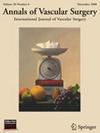评价计算机断层成像评估脾动脉瘤的准确性和可靠性。
IF 1.6
4区 医学
Q3 PERIPHERAL VASCULAR DISEASE
引用次数: 0
摘要
目的:脾动脉瘤是第三常见的腹腔动脉瘤。一些放射学特征与它们的生长速度和破裂风险有关。我们的目的是评估在计算机断层扫描(CT)上评估这些特征的准确性和可靠性。方法:检索2012年至2021年期间SAA阳性的放射学报告。2名放射科医生用我们的新放射学形式评估这些扫描,以确定可靠报告的那些标准。然后将非专家与该基线进行比较,以评估非放射科医生SAA评估的可靠性。使用Pearson和Spearman秩相关系数和Cohen Kappa统计来评估一致性。结果:一组170次扫描被评估。放射科医师对SAA直径测量的一致性很高(相关系数R=0.89-0.91)。钙化(Kappa = 0.827)和既往干预(1.0)的一致性也很高,SAA存在(0.563)、钙化百分比(0.563)、形态学(0.446)和血栓存在(0.516)的一致性中等。破裂和假性动脉瘤形态表现出较差的一致性(Kappa结论:动脉瘤直径、钙化和以前的干预是放射科医生报告的唯一高度一致的特征。其他SAA特征仅达到中等或较差的一致性,因此在研究和临床环境中应谨慎使用。本文章由计算机程序翻译,如有差异,请以英文原文为准。
Evaluating the Accuracy and Reliability of Splenic Artery Aneurysm Assessment on Computed Tomography Imaging
Background
Splenic artery aneurysms (SAAs) are the third most common abdominal arterial aneurysm. Several radiological features have been associated with their growth rate and rupture risk. We aim to evaluate the accuracy and reliability in assessing these features on computed tomography scans.
Methods
Radiological reports were searched for scans positive for SAA between 2012 and 2021 inclusive. These scans were assessed with our novel radiological proforma by 2 radiologists to determine those criteria which were reliably reported. A nonexpert was then compared against this baseline to assess the reliability of SAA assessment by nonradiologists. Pearson and Spearman rank correlation coefficients and Cohen Kappa statistics was used to assess agreement.
Results
A cohort of 170 scans was assessed. A high degree of agreement (correlation coefficient r = 0.89–0.91) was achieved by radiologists for SAA diameter measurement. A high level of agreement was also achieved for calcification (Kappa = 0.827) and previous intervention (1.0), moderate agreement for presence of SAA (0.563), calcification percentage (0.563), morphology (0.446), and presence of thrombus (0.516). Rupture and pseudoaneurysm morphology demonstrated poor agreement (Kappa <0.01) but were rare events limiting interpretation. A nonexpert could achieve comparable diameter measurements (P < 0.05) but had consistently lower kappa agreements for all aneurysm characteristics compared to radiologists.
Conclusion
Aneurysm diameter, calcification, and previous intervention were the only features reported with high agreement between radiologists. Other SAA characteristics only achieved moderate or poor agreement and so should be used with caution in research and clinical settings.
求助全文
通过发布文献求助,成功后即可免费获取论文全文。
去求助
来源期刊
CiteScore
3.00
自引率
13.30%
发文量
603
审稿时长
50 days
期刊介绍:
Annals of Vascular Surgery, published eight times a year, invites original manuscripts reporting clinical and experimental work in vascular surgery for peer review. Articles may be submitted for the following sections of the journal:
Clinical Research (reports of clinical series, new drug or medical device trials)
Basic Science Research (new investigations, experimental work)
Case Reports (reports on a limited series of patients)
General Reviews (scholarly review of the existing literature on a relevant topic)
Developments in Endovascular and Endoscopic Surgery
Selected Techniques (technical maneuvers)
Historical Notes (interesting vignettes from the early days of vascular surgery)
Editorials/Correspondence

 求助内容:
求助内容: 应助结果提醒方式:
应助结果提醒方式:


